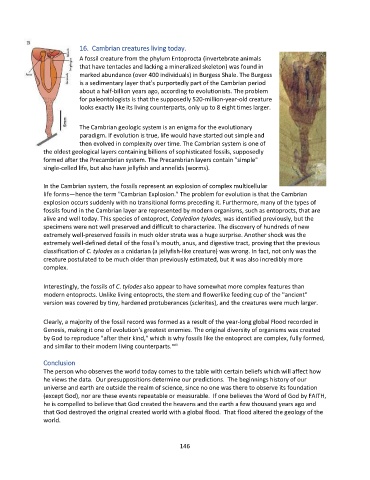Page 148 - Doctrine and History of the Preservation of the Bible revised
P. 148
16. Cambrian creatures living today.
A fossil creature from the phylum Entoprocta (invertebrate animals
that have tentacles and lacking a mineralized skeleton) was found in
marked abundance (over 400 individuals) in Burgess Shale. The Burgess
is a sedimentary layer that's purportedly part of the Cambrian period
about a half-billion years ago, according to evolutionists. The problem
for paleontologists is that the supposedly 520-million-year-old creature
looks exactly like its living counterparts, only up to 8 eight times larger.
The Cambrian geologic system is an enigma for the evolutionary
paradigm. If evolution is true, life would have started out simple and
then evolved in complexity over time. The Cambrian system is one of
the oldest geological layers containing billions of sophisticated fossils, supposedly
formed after the Precambrian system. The Precambrian layers contain "simple"
single-celled life, but also have jellyfish and annelids (worms).
In the Cambrian system, the fossils represent an explosion of complex multicellular
life forms—hence the term "Cambrian Explosion." The problem for evolution is that the Cambrian
explosion occurs suddenly with no transitional forms preceding it. Furthermore, many of the types of
fossils found in the Cambrian layer are represented by modern organisms, such as entoprocts, that are
alive and well today. This species of entoproct, Cotyledion tylodes, was identified previously, but the
specimens were not well preserved and difficult to characterize. The discovery of hundreds of new
extremely well-preserved fossils in much older strata was a huge surprise. Another shock was the
extremely well-defined detail of the fossil's mouth, anus, and digestive tract, proving that the previous
classification of C. tylodes as a cnidarian (a jellyfish-like creature) was wrong. In fact, not only was the
creature postulated to be much older than previously estimated, but it was also incredibly more
complex.
Interestingly, the fossils of C. tylodes also appear to have somewhat more complex features than
modern entoprocts. Unlike living entoprocts, the stem and flowerlike feeding cup of the "ancient"
version was covered by tiny, hardened protuberances (sclerites), and the creatures were much larger.
Clearly, a majority of the fossil record was formed as a result of the year-long global Flood recorded in
Genesis, making it one of evolution's greatest enemies. The original diversity of organisms was created
by God to reproduce "after their kind," which is why fossils like the entoproct are complex, fully formed,
and similar to their modern living counterparts. xciii
Conclusion
The person who observes the world today comes to the table with certain beliefs which will affect how
he views the data. Our presuppositions determine our predictions. The beginnings history of our
universe and earth are outside the realm of science, since no one was there to observe its foundation
(except God), nor are these events repeatable or measurable. If one believes the Word of God by FAITH,
he is compelled to believe that God created the heavens and the earth a few thousand years ago and
that God destroyed the original created world with a global flood. That flood altered the geology of the
world.
146

